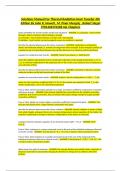Exam (elaborations)
Thermal Radiation Heat Transfer 6th Edition By John R. Howell , M. Pinar Mengüç , Robert Siegel 9781466593268 ALL Chapters
- Course
- Institution
- Book
Thermal Radiation Heat Transfer 6th Edition By John R. Howell , M. Pinar Mengüç , Robert Siegel 9781466593268 ALL Chapters
[Show more]



